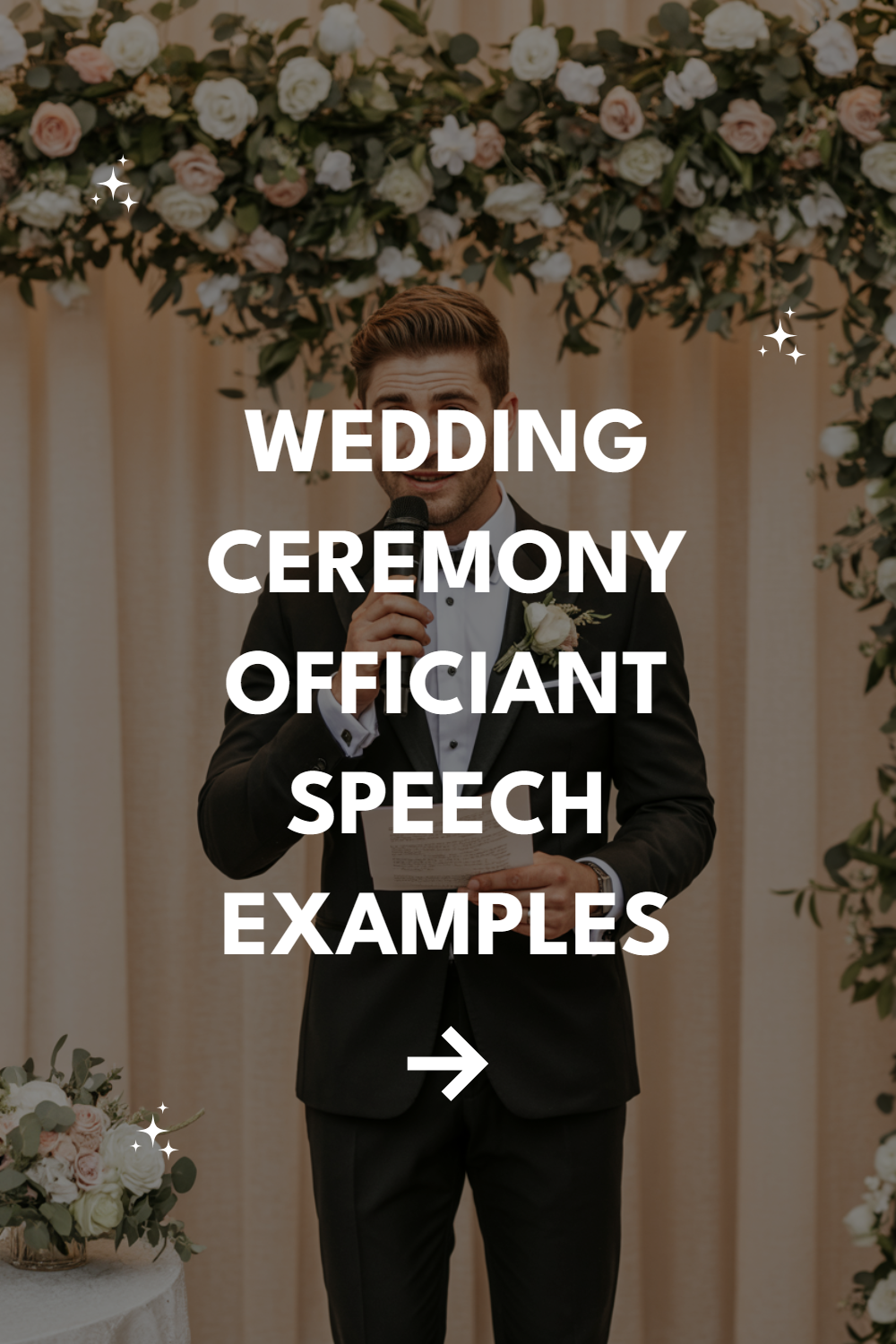Getting married means someone has to stand up there and actually make it official. Whether you’re choosing a friend, family member, or professional celebrant, the words they speak will shape one of the most important moments of your life.
Here are five distinct officiant speech examples that capture different tones and styles, each designed to create meaningful moments while keeping your guests engaged and your hearts full.
The Warm Traditional Ceremony
This style honors classic wedding traditions while maintaining a personal touch. Perfect for couples who want timeless elegance without feeling stuffy or overly formal.
The beauty of this style lies in its ability to feel both intimate and universal. It acknowledges the weight of tradition while speaking directly to the couple’s specific journey.
This speech works because it balances the ceremonial aspects people expect with genuine emotion. It gives families the traditional elements they cherish while making the couple feel truly seen.
“Dearly beloved, we gather here today not just as witnesses, but as the community that has watched Sarah and Michael’s love story unfold. Some of you have been there since childhood scraped knees and first heartbreaks. Others joined their journey more recently, but all of you have played a part in bringing them to this moment.
Marriage is both an ancient institution and a deeply personal promise. Today, Sarah and Michael choose to weave their individual stories into one shared narrative. They’re not losing themselves in this union—they’re choosing to build something bigger than either could create alone.
Sarah, when you met Michael, you told your sister you’d found someone who made you want to be brave. Michael, you said Sarah helped you understand the difference between being comfortable and being truly at peace. Today, you’re promising to continue being those people for each other.
The rings you’ll exchange aren’t just symbols—they’re daily reminders of the choice you’re making right now. The choice to love each other not just when it’s easy, but especially when it requires courage, patience, and forgiveness.”
The Heartfelt Personal Story
Sometimes the most powerful speeches come from sharing the couple’s actual journey. This style works beautifully when the officiant knows the couple well and can speak authentically about their relationship.
Personal stories create immediate connection. Guests lean in because they’re hearing something real, something that helps them understand why these two people belong together.
The key here is choosing stories that reveal character rather than just recounting events. The best anecdotes show how the couple brings out each other’s best qualities.
“Three years ago, Emma called me crying because she’d accidentally double-booked herself for a work conference and her best friend’s birthday party. She was spiraling about letting people down, convinced she was a terrible person. That’s when Jake showed up at her apartment with a detailed plan, color-coded spreadsheets, and enough Thai food to feed a small army.
He didn’t just solve her scheduling crisis—he helped her see that caring so much about everyone else’s happiness was actually one of her greatest strengths. That night, Emma realized she’d found someone who didn’t just accept her anxiety; he helped her transform it into something powerful.
Jake, you’ve always been the steady one, the planner, the guy who reads instruction manuals before assembling furniture. But Emma taught you that some of life’s best moments happen when you throw the plan out the window and trust your heart instead.
Emma, your compassion for others sometimes makes you forget to be kind to yourself. Jake sees that generous heart and reflects it back to you, helping you understand that you deserve the same love you give so freely to everyone else.”
Today, you’re promising to keep being those people for each other—the ones who show up with solutions and Thai food, who encourage bravery and celebrate sensitivity. You’re choosing to build a life where both planning and spontaneity have their place.”
The Light-Hearted Contemporary
Not every couple wants their ceremony to feel like a solemn ritual. This style brings warmth and humor while still honoring the significance of the moment.
Humor works in wedding ceremonies when it feels natural and affectionate, not forced or at anyone’s expense. The goal is to make people smile, not perform a comedy routine.
The contemporary style allows for cultural references and casual language while maintaining the ceremony’s emotional weight. It feels like a conversation rather than a performance.
“Friends, family, and that one college roommate who somehow managed to get here despite missing every other important event for the past five years—welcome! We’re here because Alex and Jordan have decided to make their relationship legally binding, which means Jordan can finally put Alex on their health insurance.
But seriously, we’re here because these two have figured out something that frankly impresses the hell out of all of us. They’ve learned how to be completely themselves while also being part of something bigger.
Alex, you once told me that Jordan was the first person who made you feel like your weirdness was actually a feature, not a bug. Jordan, you said Alex helped you understand that being decisive and being flexible aren’t opposites—they’re dance partners.
You two have spent the last four years proving that love isn’t just about finding someone you can live with. It’s about finding someone you can’t imagine living without, even when they leave coffee cups in weird places or insist on watching true crime documentaries during dinner.
Today, you’re promising to keep choosing each other, coffee cup chaos and all. You’re committing to being each other’s favorite person, biggest supporter, and most trusted co-conspirator in this beautiful mess we call life.”
The Spiritual and Reflective
For couples who want their ceremony to feel sacred without being tied to specific religious traditions, this style offers depth and meaning through universal spiritual themes.
This style works by tapping into shared human experiences and universal truths. It creates reverence without requiring specific beliefs.
Spiritual language works when it feels authentic rather than borrowed. The best spiritual ceremonies speak to something larger while remaining grounded in the couple’s actual relationship.
“We gather in this moment between what was and what will be, in the sacred space where two souls choose to become one family. The trees around us have witnessed countless seasons of growth, change, and renewal. Today, they witness another beginning.
Love is the closest thing we have to magic in this world. It transforms strangers into family, turns ordinary moments into treasured memories, and gives us the courage to promise forever to another imperfect human being.
Maria and David, your love story began as so many do—with recognition. Not just attraction, but the deeper recognition of finding someone whose soul speaks the same language as yours. You saw in each other not just who you were, but who you could become together.
The vows you’ll speak today are more than words—they’re intentions you’re releasing into the universe. They’re promises that will echo in your hearts during quiet Sunday mornings and challenging Tuesday afternoons alike.
As you exchange rings, you’re participating in a ritual as old as humanity itself—the public declaration that two people choose to share their journey. You’re saying that whatever comes, you’ll face it together, drawing strength from the love that brought you here.”
The Brief and Beautiful
Sometimes the most powerful ceremonies are the most concise. This style proves that meaningful doesn’t require lengthy when every word carries weight.
Brief ceremonies work by focusing on the essential elements without elaborate explanation. Every sentence serves a purpose, creating impact through precision rather than length.
The power of brevity lies in its ability to cut straight to the heart of the matter. When time is limited or the couple prefers simplicity, this style delivers maximum emotional impact with minimal words.
“Love brought us here today. Not just the love between Rachel and Sam, but the love of everyone who helped shape them into the people standing before us. You are surrounded by your chosen family, and they are here to witness your choice to become family to each other.
Rachel, Sam—you’ve already built a life together. You’ve navigated challenges, celebrated victories, and learned how to be partners in the daily adventure of being human. Today, you’re making that partnership official.
The promises you make today aren’t just about the future—they’re about honoring what you’ve already created together. You’re not just promising to love each other; you’re promising to keep choosing love, even when it’s hard.
Your rings represent the continuous nature of your commitment. No beginning, no end, just the ongoing choice to be present for each other’s joy and growth.
By the power vested in me and the love surrounding us, I now pronounce you married. You may kiss your spouse and begin this new chapter of your already beautiful story.”
Choosing Your Perfect Ceremony Style
The best officiant speech matches your personalities, relationship, and vision for your wedding day. Consider what feels most authentic to who you are as a couple.
Traditional ceremonies work beautifully for couples who value time-honored rituals and want their families to feel completely comfortable. Personal story ceremonies shine when the officiant knows you well and can speak authentically about your journey together.
Contemporary styles suit couples who want their ceremony to feel like a natural extension of their everyday relationship. Spiritual ceremonies create sacred space for couples who want depth without specific religious requirements.
Brief ceremonies perfect for couples who prefer simplicity or have time constraints while still wanting meaningful moments. The key is matching the style to your authentic selves rather than choosing what you think you should want.


